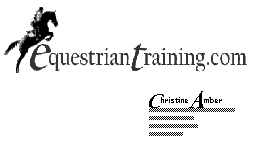
I am always looking for "pony adventures" -- new and fun equestrian experiences. I enjoy the solitude and obsession of arena work, the focus of refining an average trot into a buoyant, swinging, free floating rhythm. I like being with just the horse and myself, or the quiet rider friend. But, the child in me remembers the sheer joy of galloping through an open field and the dry oat grass crackling as the horse rushes through it. I really love the times when I'm not focusing and refining my skills, the times of just enjoying the horse as he was meant to be in nature and being the fortunate passenger of a good natured beast.
A few years back, one of my clients was told an exciting story about hunting. Not about rifles and deer, but about hounds and horses, field hunting. Being a California Native, this was a pony adventure I had yet to try. I had heard of, or read about hunting in childhood books. It conjured up mental pictures of riders in red coats, dew-dropped grass, green hedges and long legged sleek horses gallivanting across the country side.
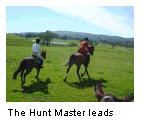
When I took a trip to England some years back, I had purchased a hunting flask. Well, with the excitement of my client's story, my imagination and the wild possibilities that I could mix in that little flask, hunting sounded like something that would be a very fun "pony adventure". Luckily, my client forwarded me some email from the local pony club with an entry to the hunt club's Hunter Pace, and that is how my newest pony adventure began.
I'm not going to tell you about field hunting, because I've yet to get that far into my new adventure. To date, i've ridden in several hunter paces and most recently a mock hunt. The mock hunt is what I'm going to tell you about.
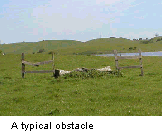 There are no hounds, it is just the Hunt Master and his field of riders. There may be several different fields of riders who ride at a particular pace or speed, with or without obstacles such as logs, ditches, fences, coops or water. Each field has a hunt master who sets the pace and in a mock hunt, determines the route and obstacles that create the best training opportunity for horses and riders, and then the master makes adjustments to pace or route that accommodate any horse or rider having difficulty.
There are no hounds, it is just the Hunt Master and his field of riders. There may be several different fields of riders who ride at a particular pace or speed, with or without obstacles such as logs, ditches, fences, coops or water. Each field has a hunt master who sets the pace and in a mock hunt, determines the route and obstacles that create the best training opportunity for horses and riders, and then the master makes adjustments to pace or route that accommodate any horse or rider having difficulty.
My Mock Hunt was like a semi private lesson. It was just the end of the club's formal hunting season, and so the turnout for the mock hunt was small. There were five of us. The protocol of dress was "formal", a black coat, field boots and black helmet. However, the invitation to the mock hunt welcomed varied attire and tack as long the rider wore a helmet and proper footwear, making the introduction to the sport most hospitable. In our small group we even had an Australian saddle. The weather was warm and coat's became optional. I dress up so infrequently, that it was fun to keep my coat on.
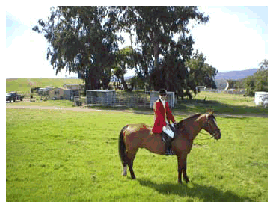 We met on a beautiful spring morning at a private working cattle ranch in Portola Valley. The grass was fresh and green, the earth soft and damp, the sun was warm, the sky was clear; the makings for a perfect riding day. Our Hunt Master, Jef, introduced me the other riders and talked about how the day would go. Some of us would be jumping. The other riders would ride along at our pace but forego the obstacles. The ride would be comprised of "runs"--moderate canters across varied terrain for durations of a few minutes or perhaps a mile. Between each run, we would have a "check"--an opportunity to check on every horse and rider, to check the surroundings, to check our girths. In a real hunt it would be the time to check that all the hounds had returned to the pack. There was time for asking and answering questions, and then Tally-ho, down the road we began.
We met on a beautiful spring morning at a private working cattle ranch in Portola Valley. The grass was fresh and green, the earth soft and damp, the sun was warm, the sky was clear; the makings for a perfect riding day. Our Hunt Master, Jef, introduced me the other riders and talked about how the day would go. Some of us would be jumping. The other riders would ride along at our pace but forego the obstacles. The ride would be comprised of "runs"--moderate canters across varied terrain for durations of a few minutes or perhaps a mile. Between each run, we would have a "check"--an opportunity to check on every horse and rider, to check the surroundings, to check our girths. In a real hunt it would be the time to check that all the hounds had returned to the pack. There was time for asking and answering questions, and then Tally-ho, down the road we began.
Our first run was a warm-up of an easy trot, up and down some very gently rolling hills. Then we all convened atop a small knoll and looked out over the expanse. After our check, Jef pointed out logs and coops on the distant horizon. Truthfully, I couldn't see what he was describing; I trusted that as we got closer I'd figure it out and take it in stride.
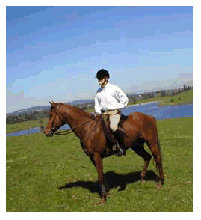 We began a gentle canter, popped over a log, down a hill, up a hill, over a coop and checked again. In the distance were some beautiful homes and small clusters of cattle grazing the mountain side. Before our third run, Jef explained that we would be dropping down to cross a small creek. He explained that in the water shed, there was more greenery and brush where birds may be; we should always be aware when approaching this terrain that the birds might scoop upward and startle the horses.
We began a gentle canter, popped over a log, down a hill, up a hill, over a coop and checked again. In the distance were some beautiful homes and small clusters of cattle grazing the mountain side. Before our third run, Jef explained that we would be dropping down to cross a small creek. He explained that in the water shed, there was more greenery and brush where birds may be; we should always be aware when approaching this terrain that the birds might scoop upward and startle the horses.
We walked and jogged easily along as I listened to stories about the hunts of the season. Just the week before, at the last formal hunt of the season, there were three fields of 20 horses that worked a 1200 acre ranch near Sacramento. The little stream we crossed was crystal clear and calm. Two ducks took flight from the under growth. Above us a black-shouldered kite floated above the fringe of the giant oak branches. They told me just last year, there was a nesting pair of kites that could be seen. After ascending the stream bed, we cantered to the next hilltop.
Looking down to the next valley was a shimmering lake held captive by a damn of large, irregular shaped rocks that formed a levy. We would go down and cross the lake, taking care not to disturb the grazing cattle.
The water was clear and the footing was firm. The field of riders rode together through the water. My horse, Pickle, loves the water. We stopped long enough for him to intently enjoy splashing everyone!.
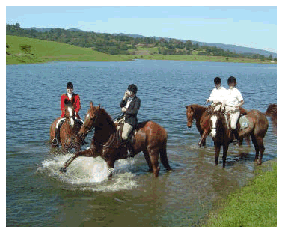
Civilization buzzed in the distance as Highway 280 sawed a path between the rolling expanse.
After each check we walked and talked. We met other riders out for a hack and chatted with them while we walked along a gravel road. Then we crossed under the freeway, through a tunnel. We had several gates and according to the "rule of the country", we left each gate opened or closed as it was found.
A great blue heron skipped over the grassy knobs in front of us, teasing the tufts of grass before it finally flew up over the horizon. We looked over to the red roofs at Stanford University. The Hunt Master's wife told me Mrs. Stanford wanted all the roofs red so she could see them from heaven.
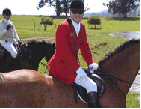 Master Jef explained to us during one of our checks that we would be cantering up some steeper inclines. To avoid stressing the horses, we would canter, winding along the side of the hills gradually climbing, rather than facing directly uphill. When we traveled over flat open terrain, he told us to make note of densely tufted grassy areas that might be wet, the bottom of swales that might be boggy, or mounds of loose dirt where squirrels might live. Jef and Gil, another rider told me the horses learn quickly to avoid problem areas, and even though my horse was quite excited he never took a bad step.
Master Jef explained to us during one of our checks that we would be cantering up some steeper inclines. To avoid stressing the horses, we would canter, winding along the side of the hills gradually climbing, rather than facing directly uphill. When we traveled over flat open terrain, he told us to make note of densely tufted grassy areas that might be wet, the bottom of swales that might be boggy, or mounds of loose dirt where squirrels might live. Jef and Gil, another rider told me the horses learn quickly to avoid problem areas, and even though my horse was quite excited he never took a bad step.
One more tunnel under Highway 280 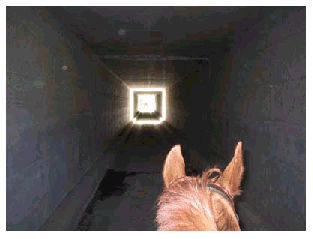 and we ambled an easy walk down the road, back to the stable area. A sip of port and a bag of carrots were the toast to a perfectly delectable ride, my newest pony adventure, the mock hunt.
and we ambled an easy walk down the road, back to the stable area. A sip of port and a bag of carrots were the toast to a perfectly delectable ride, my newest pony adventure, the mock hunt.
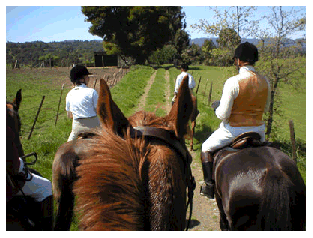
amber@equestriantraining.com
Use the "Back" button on your browser to return to the homepage